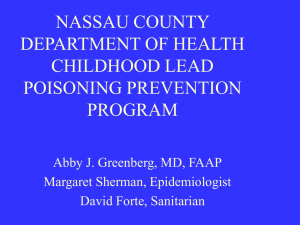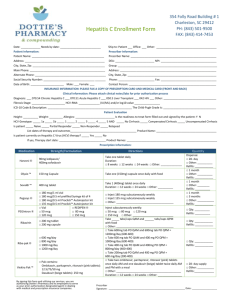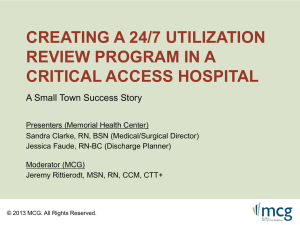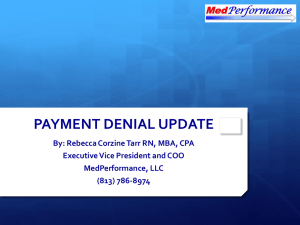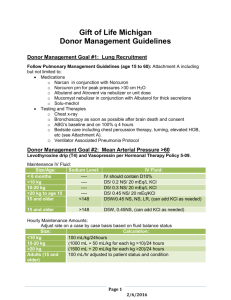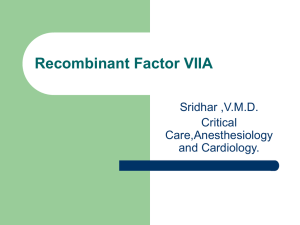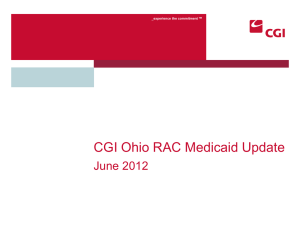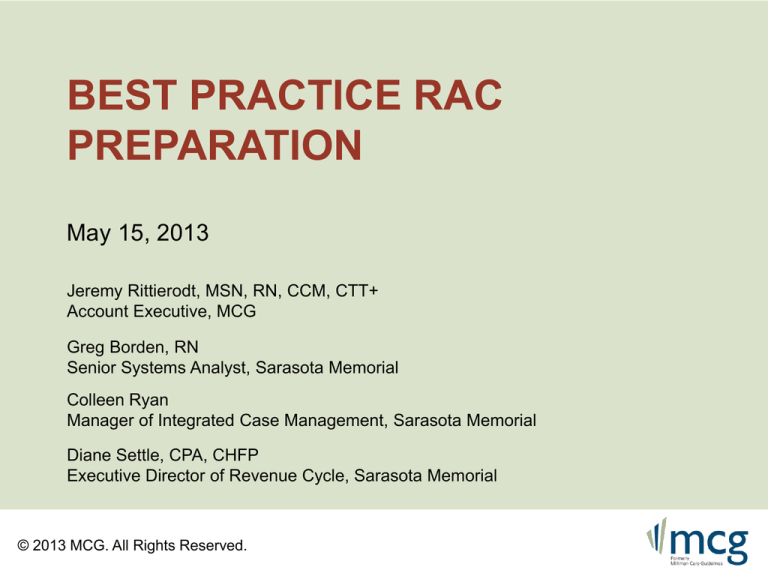
BEST PRACTICE RAC
PREPARATION
May 15, 2013
Jeremy Rittierodt, MSN, RN, CCM, CTT+
Account Executive, MCG
Greg Borden, RN
Senior Systems Analyst, Sarasota Memorial
Colleen Ryan
Manager of Integrated Case Management, Sarasota Memorial
Diane Settle, CPA, CHFP
Executive Director of Revenue Cycle, Sarasota Memorial
© 2013 MCG. All Rights Reserved.
Overview
• The RAC program was created through the
Medicare Modernization Act (MMA) of 2003 to
identify inappropriate payments and recoup
overpayments under parts A and B of Medicare
• RAC reviews are retrospective, with a look-back
period of three years
• Congress made the RAC program permanent in
2010, extending it to all 50 states
2
© 2013 MCG. All Rights Reserved.
Impact on Hospitals
• RACs made medical record requests associated with
$6.4 billion in Medicare payments in 2012
• Hospitals reported nearly $1.3 billion in automated
and complex denials from RACs in 2012
• The average value of an automated denial was $734;
the average value of a complex denial was $5,358
• During Q4 2012, 43% of all hospitals reported
spending more than $25,000 managing the RAC
process; 13% spent more than $100,000
Source: AHA RACTRAC Survey, 4th Quarter 2012
3
© 2013 MCG. All Rights Reserved.
Medical Necessity Denials with the
Largest Financial Impact
MS-DRG
Percent of
Hospitals
Description
247
PERC CARDIOVASC PROC W DRUGELUTING STENT W/O MCC
21%
312
SYNCOPE & COLLAPSE
14%
392
ESOPHAGITIS, GASTROENT & MISC
DIGEST DISORDERS W/O MCC
13%
313
CHEST PAIN
13%
491
BACK & NECK PROC EXC SPINAL FUSION
W/O CC/MCC
5%
Source: AHA RACTRAC Survey, 4th Quarter 2012
4
© 2013 MCG. All Rights Reserved.
Establishing Medical Necessity:
Syncope
5
© 2013 MCG. All Rights Reserved.
Best Practice RAC Preparation
I.
Completely and Accurately Document All Clinical
Decisions
II. Measure Patient Progress Against Optimal Care
Pathways
III. Track and Report on Variances from Optimal Care
IV. Identify and Prepare for the Issues RACs Are
Targeting
V. Respond Promptly to RAC Demand Letters
VI. Place Case Managers in the Emergency Department,
Seven Days A Week
VII. Use Internal Audits to Prepare for RAC Audits
6
© 2013 MCG. All Rights Reserved.
Completely and Accurately Document
All Clinical Decisions
• Inpatient admissions and extended stays
• Changes in level of care (e.g., observation to inpatient)
• Surgery and other procedures
• Care planning
7
© 2013 MCG. All Rights Reserved.
Measure Patient Progress Against
Optimal Care Pathways
• Identify the optimal care pathway for each patient
• Make sure everyone on the care team understands
the care plan
• Document the medical necessity of every decision
along the pathway
8
© 2013 MCG. All Rights Reserved.
Track and Report on Variances from
Optimal Care
• What are the variances?
– Medically necessary
– Potentially avoidable
– Favorable
• Where are the variances?
• How should we respond to them?
9
© 2013 MCG. All Rights Reserved.
Identify and Prepare for Issues RACs
Are Targeting
• Short stays
• Interventional cardiology
• Syncope
• Gastroenteritis
• Chest pain
• Joint and spine surgery
10
© 2013 MCG. All Rights Reserved.
Respond Promptly to RAC Demand
Letters
• Put a RAC team in place
• Know the response deadlines
• Centralize the receipt and management
of demand letters
• Only appeal denials that make sense
– Winnable appeals
– Appeals worth the investment of time and
money
11
© 2013 MCG. All Rights Reserved.
Place Case Managers in the Emergency
Department, Seven Days a Week
• Determine a strategy for case management in the
ED (24 hours a day versus peak hours)
• Make sure case managers engage with providers
• Consider the role of case managers in other areas
of the hospital system
12
© 2013 MCG. All Rights Reserved.
Use Internal Audits to Prepare for RAC
Audits
• Identify areas RACs are targeting
• Review documentation in those areas
– Put on your RAC hat
• Look at variances and opportunities for improvement
• Promote ongoing communication between appeals
and case management staff
13
© 2013 MCG. All Rights Reserved.
Sarasota Memorial
• Sarasota memorial Health Care System, an 806-bed
regional medical center, is among the largest public
health systems in Florida
• Founded in 1925, the system has about 4,000 staff,
802 physicians, and 1,000 volunteers
14
© 2013 MCG. All Rights Reserved.
Structure of Sarasota Memorial’s Case
Management Program
• Original case management model
• Design and adoption of Triad Model
– Design process
– Structure of Triad Model
– How Triad interacts with other departments
– Benefits and drawbacks of Triad Model
15
© 2013 MCG. All Rights Reserved.
How Sarasota Memorial Prevents and
Appeals RAC Denials
• Prevention
– RAC committee – members
– Identified issues
• Appeals
– Medical necessity team
– Review/appeal process
16
© 2013 MCG. All Rights Reserved.
Role of MCG Products in Integrated
Case Management and RAC Defense
• Integrated case management
• RAC defense
– Admission review
17
© 2013 MCG. All Rights Reserved.
Impact of Integrated Case Management
Program on RAC Denials and Appeals
• Demonstration period
– Volume
– Success rate
• Permanent RAC program
– Volume
– Success rate – % still in appeal
18
© 2013 MCG. All Rights Reserved.
Performance Prior to Integrated Case
Management
• Sarasota Memorial contracted with Milliman to:
– Review 100 cases for medical necessity against admission and
continued stay criteria
– Review the current utilization process
– Design a case management/physician advisor process
• Instituted an electronic case management tool to track:
– Medical necessity
– Delay days/delay rates
– Denials
19
© 2013 MCG. All Rights Reserved.
Performance After the Introduction of
Integrated Case Management
• Current review processes
• Delay rates
• Physician advisor rates
• Denial tracking
20
© 2013 MCG. All Rights Reserved.
Questions
Jeremy Rittierodt
jeremy.rittierodt@careguidelines.com
Greg Borden
Greg-Borden@smh.com
Colleen Ryan
Colleen-Ryan@smh.com
Diane Settle
Diane-Settle@smh.com
21
© 2013 MCG. All Rights Reserved.

